“Handsome? Yes, but only feather deep. Actually, for their size and weight, magpies are probably the most murderous fiends of the whole avian world. They own a hankering for warm blood and red meat that is little short of phenomenal.” – Bert Popowski, “Magpies are Murder!”, Calling All Varmints (1952)
As I finished my hike, I heard another visitor at the trailhead exclaim: “I just saw one of those cute tuxedo birds!”
I admit it: My first impulse was to roll my eyes at this description of one of the most visible birds around my home in the Western United States, the black-billed magpie (Pica hudsonia). But I had to give some credit, too. The magpie’s striking plumage do resemble a tuxedo, even if sunlight reveals the “black” feathers are actually an iridescent blue-green.
I also know that magpies are real crowd pleasers for visitors to Western U.S. national parks and public lands. While those of us living here may see them daily around our neighborhoods, those outside the region appreciate the bird’s beauty and antics.
And this magpie appreciation is a welcome shift from past attitudes. Today, even those of us familiar with magpies mostly enjoy seeing the bird. Sure, they may wake us with their raucus calls, or annoy us when they raid a fruit tree. But for the most part, the magpie escapes notice.
It’s easy to forget that, not so long ago, the black-billed magpie was one of the most vilified birds in North America, if not the world.
Intelligent Opportunists
Black-billed magpies are corvids, in the same family as crows, ravens and jays. Like other corvids, they’re highly intelligent birds. They also have a complex social hierarchy; the Cornell Lab of Ornithology reports that “In groups, males establish dominance through a stretch display: raising the bill in the air and flashing their white eyelids.”
The bulk of a typical magpie’s diet is made up of insects, but they’re opportunists. They feast on carrion, and it’s a common sight along Western roads to see a flock perched on roadkill. They eat fruit, bird feed, small mammals and garbage. They also eat bird eggs and fledglings, although research has shown this to be only a minor part of their diet.
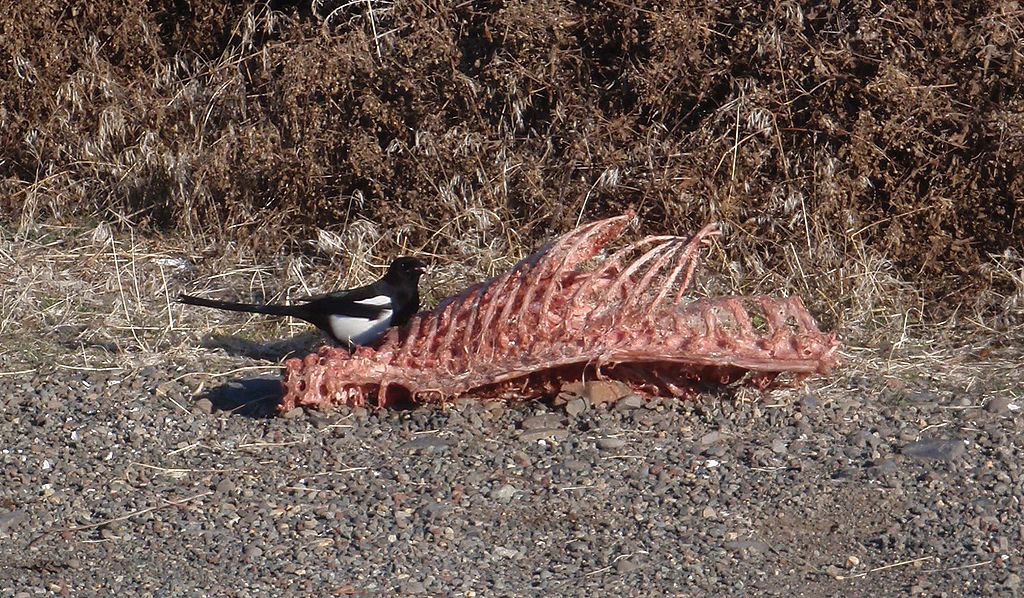
This opportunism also leads to their tangled relations with humans. Throughout the history of this continent, they’ve recognized humans as a source of easy food. They reportedly would follow American Indians on bison hunts, recognizing the potential feast left behind.
The Lewis and Clark Expedition noted that magpies often boldly entered their tents in search of food. And many modern hunters, myself included, have noticed that they (and ravens) continue to follow human hunts. I have at times been convinced that these birds have tipped me off to game. Some may consider this fantastical, but it’s happened too many times for me to dismiss it.
But in the 20th century, many people did not look at the magpie as a hunting partner. They saw the bird as a vicious threat to livestock and game. And they persecuted magpies without mercy.
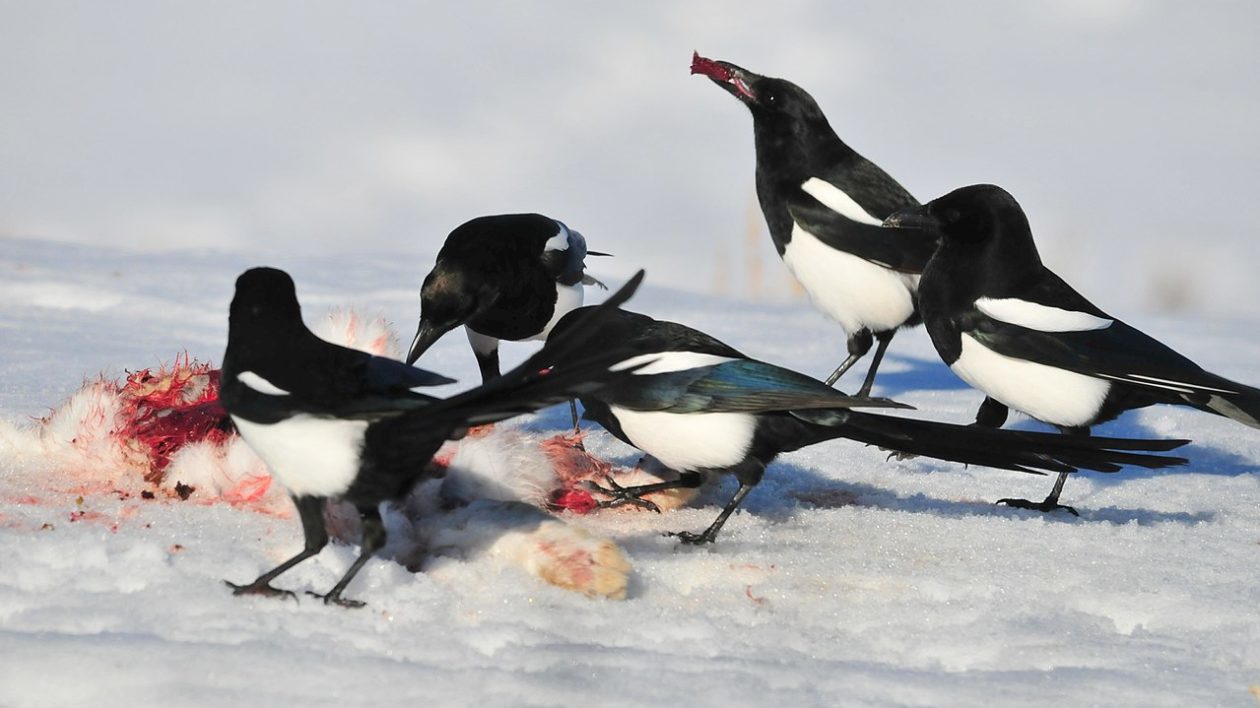
A History of Violence
Outdoor magazines and books in the mid-20th century frequently accused the magpie of gory, horrific crimes against helpless domestic animals and wildlife. Reading these accounts today, the magpie appears to be the winged equivalent of Darth Vader, or perhaps Hannibal Lecter.
Larry Koller, in his Treasury of Hunting (1965), repeats a common accusation against the bird: “Magpies are small, vicious, Western birds with the sanguinary habit of plucking out eyes of young, newly dropped fawns and kids. Then, in a flock attack, they literally eat the helpless animal alive.”
Outdoor writer Bert Popowski dismissed the eye-eating stories as mere folklore. But he wasn’t defending the magpies. In fact, he doubled down on magpie hatred and sensationalism. “Ounce for ounce they have no peer in cold-blooded rapacity,” he wrote in a chapter descriptively named “Magpies are Murder!” in his book Calling All Varmints.
This chapter includes numerous disturbing descriptions of magpies devouring, alive, adult cattle and other livestock. He quotes a rancher who attributed 50 percent of his cattle losses to magpie predation. He maintained that magpies pecked at the cattle to remove fly larvae under the skin, but then one thing led to another:
“Once they’ve opened the beef critter’s hide and gotten a taste of its blood and meat, they keep enlarging the hole. Eventually they work clear through the muscle sheath and into the abdominal cavity. The next ste is to peck through the exposed paunch and then that beef is doomed.”
Basically, in Popowski’s telling, the magpie chisels a hole into a hapless cow and then eats it from the inside out. Perhaps this was the inspiration for that scene in Alien.
What is the truth of magpie predation on cattle? As insect feeders, magpies are well-documented to land on cattle and other large mammals to pull off ticks. This habit undoubtedly contributed to the idea that magpies were actually attacking cows.
There are also some published reports of magpies pecking at wounds on cattle, including fresh brands. One published account included observations of a magpie pecking at cuts on freshly shorn sheep. As opportunistic feeders, this undoubtedly happened, and continues to occur. But such random occurrences are a far cry from the bird that writers like Popowski accused of having a preference for “raw, red meat, still alive.”
Nonetheless, these stories of magpies fueled a large-scale slaughter of the birds. Not coincidentally, writers like Koller and Popowski included tips and tricks for shooting large quantities of magpies. Popowski reported on one shoot in Manitoba where his group killed 2,000 crows and magpies, under the auspices of protecting nesting waterfowl.
Most U.S. states in magpie range officially sanctioned the slaughter, and paid a bounty on every bird killed. In Idaho, the state paid a nickel for every magpie or egg turned in, which led to the death of approximately 150,000 birds.
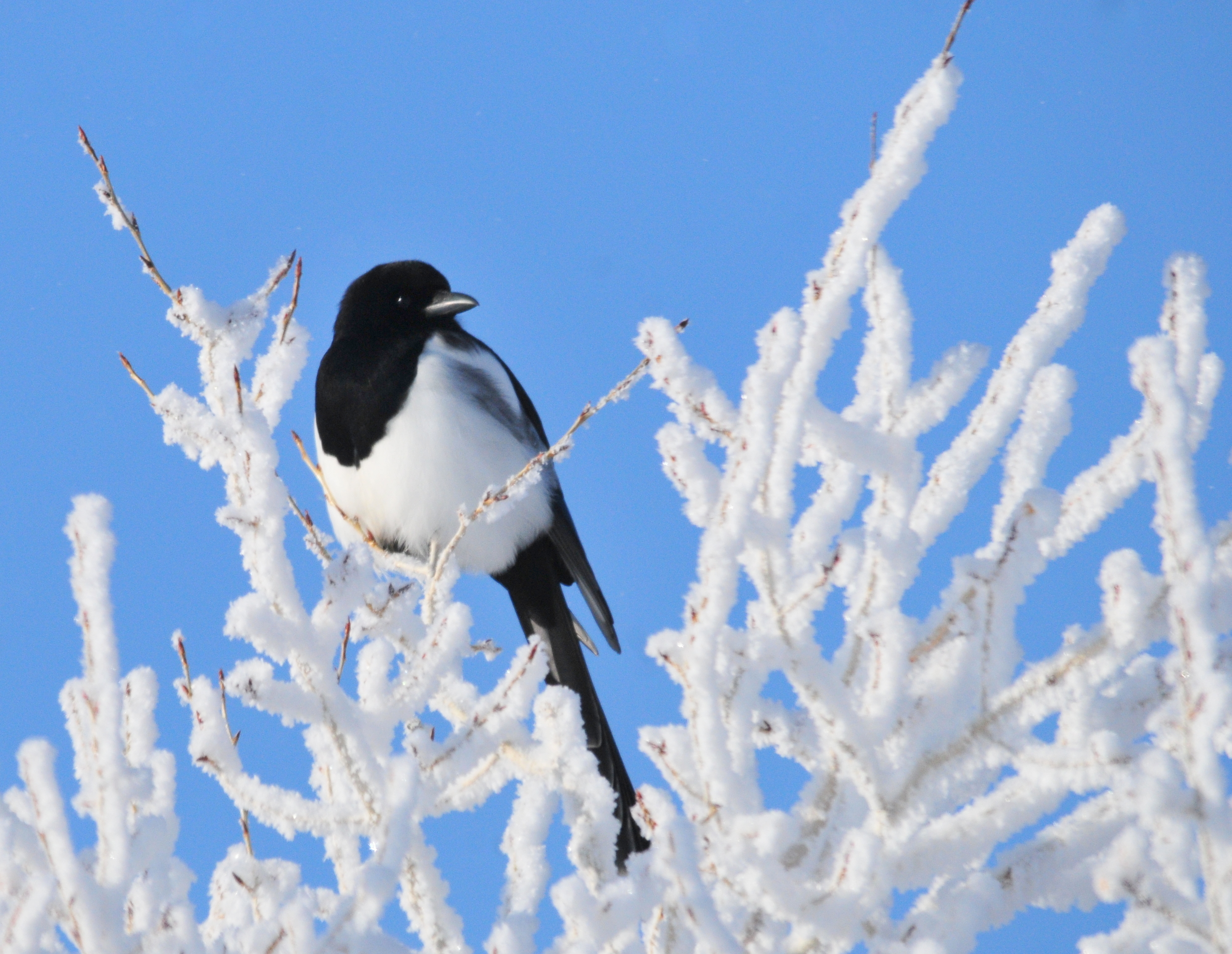
Many ranch kids trapped the birds to receive bounty payments. During his visits to the Silver Creek area of southcentral Idaho, Ernest Hemingway noticed this and devised his own twist to magpie control. Hemingway was an enthusiast of Europe’s live pigeon shoots, where pigeons were released in front of shotgunners in a target shooting competition. (It was essentially like clay target shooting, but with live birds).
Hemingway noticed the trapped magpies and created his own version of a live pigeon shoot at Silver Creek, with the trapped magpies released for shotgun shooters. According to the book Hemingway’s Guns,
“Hemingway, intrigued by the bird’s erratic flight and cunning, devised his own form of ‘pigone shooting,’ complete with rules, trophies and wagering. Mary Hemingway wrote fondly of their magpie shoots—the friends an food and wine, the wind that made the targets so difficult, and the parceling out of the betting pool.”
I heard stories firsthand of these shoots from rancher Bud Purdy, a friend of Hemingway’s who often hosted these events on his ranch. Coincidentally, Ernest’s son, Jack, and Bud Purdy both were instrumental figures in working with The Nature Conservancy to protect the Silver Creek Valley through a nature preserve and easements. I should note that, on a recent visit, magpies were constantly flying around the preserve – with no one shooting at them.
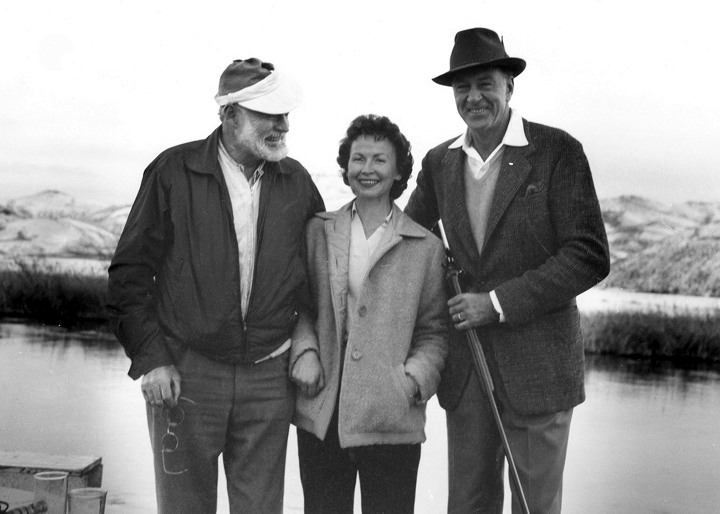
New Laws, New Threats
What changed for magpies? Quite simply, a treaty known as the Migratory Bird Treaty Act. The original act, passed in 1918, did not protect magpies or other corvids. They were added to the protected list when the act was amended in 1972. This effectively ending bounty programs and widespread persecution.
The Act does allow magpies to be killed when they are depredating crops and livestock, or causing other property damage. What constitutes property damage leaves a lot of room for interpretation. A story on National Public Radio’s Living on Earth by my friend Guy Hand summed it up this way: “It’s legal to control them if they peck at your screen door, eat Fifi’s dog food, go for the cherry tree.”
The same story describes an Idaho couple who continues to “wage war” on magpies, which also certainly occurs on ranches and in many rural areas. Still, today you’re more likely to see someone shooting a magpie with a camera than with a gun.
Today, the magpie faces bigger threats than direct persecution. While black-billed magpies remain abundant in most parts of their range, its populations have declined every year since 1966.
The Cornell Lab of Ornithology reports on one cause of the decline: “They have been vulnerable to toxic chemicals, particularly topical pesticides applied to the backs of cattle which magpies ingest when gleaning ticks off livestock.”
West Nile Virus also took a heavy toll on magpies as it spread west. The decline was well-documented on the closely related and less-numerous yellow-billed magpie (Pica nutalli), a species found only in California. Within two years of West Nile Virus arriving to the West Coast, more than 90,000 yellow-billed magpies had died…nearly half the entire population.
I have not found estimates for the toll on black-billed magpies. I know that soon after West Nile Virus was found in Boise, where I live, magpies essentially disappeared. Their calls formed part of the soundtrack for our nightly walks on the city’s greenbelt, but suddenly they ceased. They have since returned, but we still do not see them in large numbers.
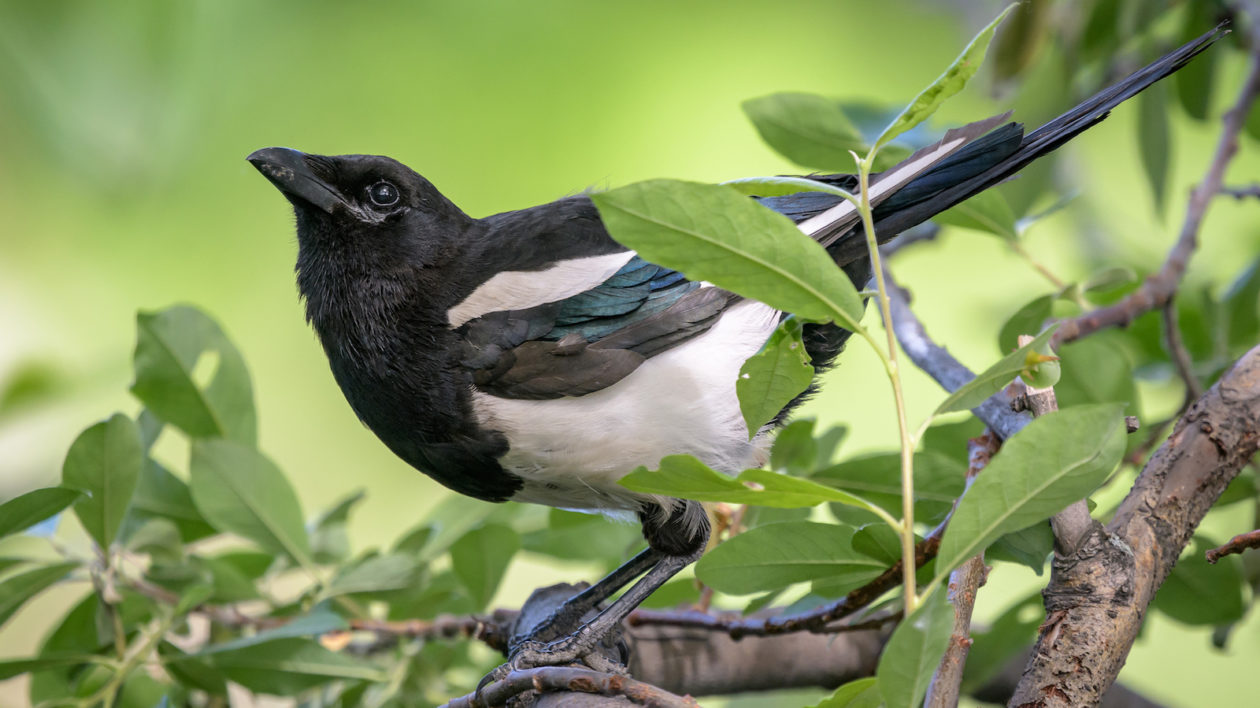
The Magpie Funeral
Delve into historical accounts of magpies, and you’ll find not only descriptions of magpie predatory behaviors, but also accounts of magpie funerals. These reports state that when a magpie dies, other magpies will travel to the spot and sit over the body for a short period of time.
It turns out, this behavior is well documented in the literature and by respected ornithologists. Cornell describes the funeral as such: “When one magpie discovers a dead magpie, it begins calling loudly to attract other magpies. The gathering of raucously calling magpies (up to 40 birds have been observed) may last for 10 to 15 minutes before the birds disperse and fly off silently.
The Living on Earth program includes an interview with magpie researcher Chuck Trost, who posits that the magpies are probably not paying their respects. I think what it is, is they’re trying to see who it is,” he said. “Because they know each other, magpies know each other, and whenever there’s a dead magpie, that means there’s an opening in the social system. And if you’re a submissive magpie you can move up one notch.”
Reporter Guy Hand respects the science. But given our history with the bird, he also suggests that maybe we should be open to other interpretations: “If we’re so quick to assign the worst human traits to magpies, can’t we just allow them just a little room for reverential reflection?”
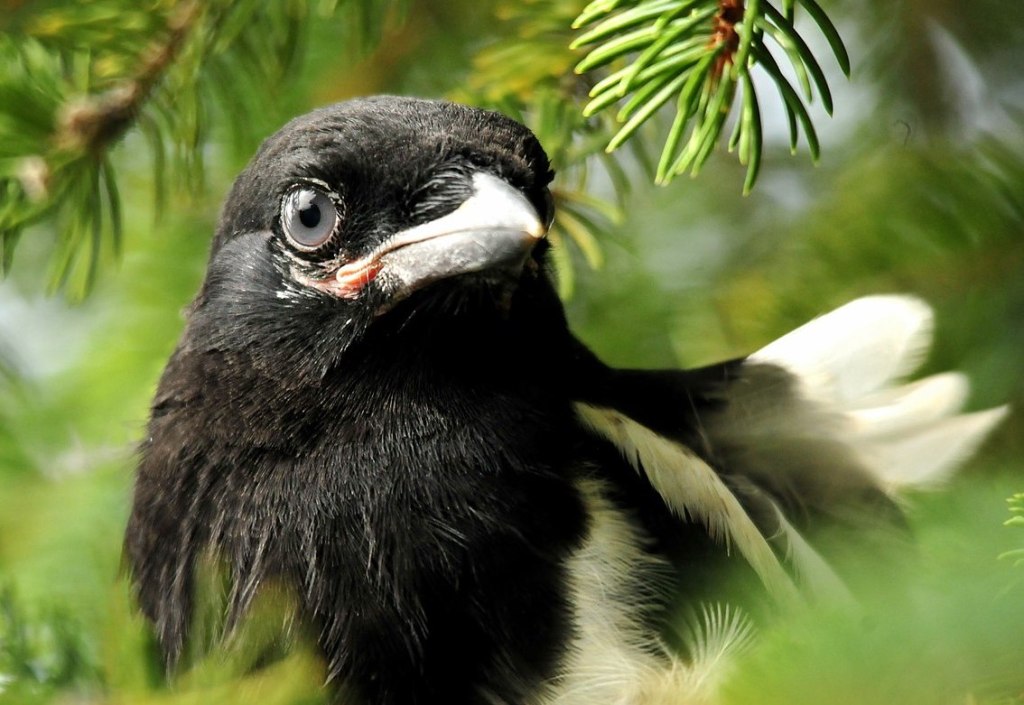



Thank you Matthew for your insightful article. I’ve seen these birds around Sacramento I believe. If I remember correctly someone that I mentioned them to had terrible things to say. Now I might have a good retort.
Are they related to crows? Their behavior sounds similar to that of crows.
Thanks for this article. I’ve often wondered why young hunters express interest in just shooting these birds for sport. Someone has given them wrong information. Humans are quick to discount or demonize any part of nature they do not understand.
We have to stop stereotyping certain animals because this only opens the door for fear and that they need to be killed. The magpies have there own problems without us thinking they don’t deserve to be here and they do. I want everything possible done to make sure they are around for us to enjoy.
Thank you for this wonderful story of magpies. They inspired a painting: Life and Death in Taos.
I am glad of your good writing and sad you are a hunter. I agree with Ellen Rathbone , humanity does have a lot to answer for! I believe it’s our responsibility to preserve and protect other living beings, human and otherwise.
Thank you for your even-handed, clear, and appreciative article. I came away from it far better informed than before.
Wonderful article. Thank you. I really enjoy watching corvids. The first time I saw magpies was in the late 1960s near Solvang, California. Fascinating birds. In 1976 I ended up living in Fair Oaks, California, near Sacramento. I would hear what to me was unusual, almost human chatter outside. I discovered my lawn was covered with magpies. I loved it. I now live near Morro Bay, California, and have had some interesting encounters with crows. Once I was gardening when I noticed a crow jumping up and down, cawing and moving toward what looked like a stick on the driveway. It would hop toward the stick, get worried about my presence about 10 feet away and then retreat. Back and forth he went, always facing me and cawing and hopping up and down. After ten minutes of this I decided to move the stick and try to figure out what was so attractive about it to the crow. As soon as I stood up, the crow flew up to the roof, still cawing and jumping up and down. The stick suddenly dashed into the garage via a small hole at the bottom of the door. It was a large lizard that had already lost its tail. I went back to gardening, feeling pretty good about saving a lizard life but the crow and his buddies spent the next hour surrounding me on the driveway, the roof, the trees and just raised hell, letting me know how unhappy they were with my interference. I also had a bird bath that I had to take down because the crows brought things like English muffins, pinto beans and snails and “washed” them in it. They let me know I was responsible for again interfering in their lives. They walked up to my sliding glass door, stared at me, cawed and cawed, and tapped on the glass. I got the message. Here’s my last story: I was in a big shopping center parking lot in La Jolla next to I-5 when I saw a crow with the handle of a plastic bag around his foot. I kept after the crow, trying to grab the bag off of his foot, when his family (I assume) flew into a nearby tree and seemed to hold a conference about this problem. I backed off and watched. Two crows flew down and carefully removed the bag from his foot and they all flew off over the busy freeway. Oh heck, here’s my absolute last story about these intelligent birds: My stepdad tried to protect the almonds on his trees from the crows with a big, plastic snake. After placing it in one tree, we all watched from the kitchen window as the crows flew around the tree and cawed in alarm. Eventually they all gathered in a large, dead tree and had one of their conferences. A scout was sent down to inspect the snake. It spent maybe ten minutes flying from tree to tree until it finally landed about five feet from the snake and shuddered. Then it took a closer look at the snake and called to the rest of the crows: “Hey, it’s a FAKE! Time for an almond feast.” Down they came as my stepdad flew out the door, broom in hand, to defend his almonds. That’s it. I love and respect these corvids. Certainly they aren’t any worse than us humans.
I witnessed a corvid funeral in my yard earlier this summer. I came home from work and saw a dead Common Raven in the grass. I went to go see it, but encountered a small group of American Crows in the tree above who raucously voiced their displeasure at my presence and were definitely there making noise in some kind of reasoning related to the dead Common Raven beneath them. So, I went inside and waited a few hours for them to leave before removing the body. Later that evening some of the crows returned for a second time and made more noise. The following morning, a few returned one last time, this time silently. I was a little surprised by this apparent cross-species “funeral” and wasn’t sure if they recognized the Raven as an individual they knew or just saw it as crow-like, or even if they witnessed or had some part in its ultimate demise. No sign of injury was apparent on the Raven, though.
All wild critters are a lot smarter than human hubris wants to admit. They all definitely understand death and pain, fear and love. It’s only humans who miss out on the richness of the lives of wild creatures. Their loss.
Save all the Magpies now and forever.
Humanity has a lot to answer for.
Thank you.
Would you be able to recommend which of the bird conservation non profits is most deserving of contributions? — “deserving” in the sense of being the most effective?
great blog posting Matt. I learned a bunch about my neighbors the magpies.
An interesting story, social omnivores have bit of a reputation for smarts. Some birds seem particularly quick at learning new tricks. I once had a robin turn into a vampire in the space of 20 minutes, it was incentivised by a dearth of invertebrates brought about by an explosion of introduced predatory wasps (Vespula). In a very remote untracked area as I ate my lunch it started by cleaning the hookgrass seeds from my legs, moved on to picking off small scabs and then started drilling into my leg getting a beak full of blood with every blow. Some kea learn to dig into a sheeps back and eat the kidney fat, they then teach the young ones, although it’s not an instinctive behaviour, these sheep often die of septicemia. It wouldn’t surprise me at all if a similar set of processes can happen with your magpies, starting with ticks, especially given the reputed intelligence of corvids.
In terms of funerals it may have been chance but one night having shot a chamois (a pest in NZ’s South Is.), it’s mate and 2 kea followed me back to the river. Later at the hut a loud wailing started up (I thought it was a Tom cat) but turned out to be a kea perched on a branch just above where I’d hung the chamois carcass. The kea, kept up it’s wailing all night until dawn. 5 months in that hut and 30 years around kea I’ve never heard anything like it before or since. The only interpretation I can manage is that the kea and chamois shared a territory and had some sort of bond going. I felt rather mean as a result.